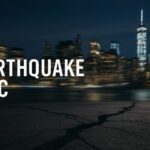When the ground shakes off the coast of Kamchatka, the Pacific listens. On July 20, 2025, a magnitude 7.4 earthquake struck the seafloor east of Russia’s Kamchatka Peninsula. The tremor was strong enough to jolt seismometers from Tokyo to Alaska, and quick enough to trigger a Russia earthquake tsunami warning that sent ripples across the Pacific, both in water and in nerves.
This wasn’t just another distant quake that fades into the background. It was a reminder of how fast things move when tectonic plates collide, and how quickly warnings can roll out or roll back. In this post, we break down what happened, what didn’t, and what you should remember next time the Pacific Plate shifts under our feet.
A Rapid Quake Sequence off Kamchatka
The earthquake struck at 52.5° N, 160.5° E, roughly 144 kilometers east of Petropavlovsk-Kamchatsky. The shaking originated about 20 kilometers below the surface, typical for a subduction zone quake. But what made this event especially sharp was the cluster of strong foreshocks and aftershocks that came in rapid succession. Multiple quakes above magnitude 6 hit within just an hour.
The main quake was initially registered as magnitude 7.5, then revised to 7.4 after data reviews by global seismic agencies. Reverse-fault motion in this area is common, since the Pacific Plate is constantly pushing beneath the smaller Okhotsk Plate. But even familiar motions can cause sudden surprises.
The region has seen stronger earthquakes in the past, including the infamous 1952 quake that generated a deadly tsunami. In this case, the energy release was large, but not catastrophic. Still, it was enough to light up the warning systems that span the Pacific.
How the Tsunami Warning Unfolded
At 06:49 UTC, the Pacific Tsunami Warning Center issued its first alert: a Russia earthquake tsunami warning was in effect for parts of Russia’s far eastern coast, and a tsunami watch was launched for Hawai‘i. The message spread quickly. PTWC used automated models to assess potential wave amplitudes and gave early estimates of under 0.3 meters for Russia’s closest bays, and less than 0.03 meters across the wider ocean.
Within minutes, deep-ocean buoys and coastal tide gauges began reporting. Russian stations saw peak waves around 7 to 9 centimeters. That’s barely enough to slosh a fishing boat. DART buoys in the Pacific stayed quiet. By 07:35 UTC, Russia’s emergency services had downgraded their alert. By 07:42, Hawai‘i’s watch was canceled too. No widespread tsunami was observed. No coastal evacuations were needed.
Still, sirens were tested, alerts were issued, and for a brief window, emergency preparedness came to life in real time.
No Big Waves, But a Big Reminder
This event won’t be remembered for destruction. It will be remembered for speed. The quake struck. The warnings went out. The science held. And the all-clear came quickly. It was a textbook case of a “short-fuse tsunami scenario,” where real-time modeling and modern sensors work together to give us breathing room, even if just minutes.
It also shows that not all big quakes make big waves. What matters more than magnitude is how the earth moves. In this case, the rupture was deep and narrow, so it lifted little water. In contrast, broad and shallow ruptures like the 2004 Indian Ocean quake can displace massive volumes of seawater and travel far with deadly force.
But don’t let the small wave size fool you. This region is known for its seismic volatility. In fact, since 2000, the Kamchatka area has produced at least seven quakes of magnitude 7.5 or greater. Only one of them caused a significant tsunami. Still, coastal communities must stay ready. The next rupture could behave very differently.
What You Should Know, Wherever You Live
If you live near the Pacific coast or visit any area with tsunami risk, keep this in your mental toolkit:
- Know the difference between a tsunami watch and a tsunami warning. A watch means potential risk, a warning means waves are expected or already happening.
- If you feel strong shaking, do not wait for a phone alert. Move inland or uphill immediately.
- Keep a go-bag ready. Water, documents, meds, flashlights, batteries.
- Learn your local evacuation routes. Know where to go and how fast you can get there.
- Pay attention to official sources. In Russia, that’s EMERCOM. In the U.S., that’s PTWC or your local emergency management agency.
Even a false alarm is a live drill. It tests your instincts, it tests your systems, and it helps you learn what works.
The Science That Caught the Wave
Behind the scenes, a whole network was watching. The Global Seismographic Network flagged the event within seconds. PTWC’s modeling center ran fast wave forecasts. DART buoys stood by to confirm or dismiss the threat. By combining seismic data, sea-level sensors, and oceanographic models, we’re getting faster and more accurate at knowing when a tsunami is coming, and when it’s not.
That’s a major win. Because when the earth shifts at sea, we don’t have hours. We have minutes. Sometimes less.
The Russia earthquake tsunami warning of July 2025 was not a disaster. It was a performance test. Nature flipped the switch, and the warning system responded quickly and clearly. While no deadly wave arrived this time, the event shows us the importance of readiness, even when the danger fizzles.
We don’t get to choose when or where the next earthquake will hit. But we can choose how prepared we are when it does.
Stay tuned to CycloneRadar. We’ll always break it down in real words, real time, for real people.


